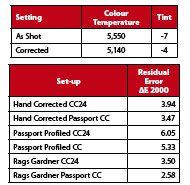articles/Digital/colourcheckerpassport-page3
X-Rite ColorChecker Passport - part 3 of 1 2 3 4
by Mike McNamee Published 01/12/2009

An error of around 3.8ΔE 2000 is in line with measurements that we have made previously when using 'simple' techniques. The Rags Gardner error of close to 2 is in line with previous results and other more sophisticated techniques. For example we obtained an error value of 1.8 using the larger ColorChecker SG chart and both Rags Gardner and Monaco profiling routines. It is important to recognise that the image correction obtained via the Rags Garner profile results in a much flatter image than that obtained with the Passport routine. This is and always has been a difference between what is colourimetrically correct and that which a client or photographer would prefer. We always express this by saying that we sell images of pretty girls in posh frocks not images of Macbeth Charts (although this is not strictly relevant!).
Overall then the initial result was slightly disappointing in that no improvement was made. However, this ignores the fact that once we had completed the routines we knew we were close, thus removing any hint of doubt. The fact that we obtained an initial test image that was close to technical correctness left little leeway for a profile to exert an influence.
Armed with this initial intelligence we repeated the tests in slightly different light to double check our results.

Test 2 Sunlit Afternoon Light
For the second test we also included a standard, full-size Macbeth ColorChecker. The lighting was slightly more tricky to assess, a slightly warm afternoon sun, and a mixture of blue sky and clouds. This was shown by the corrections needed to the white balance, something we did not have to do on Test One:
The file was opened in ACR, colour balanced with the eyedropper and the residual exposure error (-0.15 EV) was also corrected. The target was then profiled using various methods and the data analysed as follows:
The table highlights the frustration of dealing with this type of analysis; the results are almost reversed between the two types of chart but once again the Rags Gardner script out-performs the Passport profiling. Our ability to actually measure the targets on the Passport was frustrated by the plastic casing; the spectro simply would not fit into the available space. This might have shed light on the difference between the two charts - we have always found that inter-chart differences are about the same order as the errors we are trying to eliminate. Once again, with this series, the Passport produced a higher saturation result. In the deep blue swatch the difference in the chart errors was most pronounced at 8.5ΔE Lab Points.
Please Note:
There is more than one page for this Article.
You are currently on page 3
- X-Rite ColorChecker Passport page 1
- X-Rite ColorChecker Passport page 2
- X-Rite ColorChecker Passport page 3
- X-Rite ColorChecker Passport page 4
1st Published 01/12/2009
last update 09/12/2022 14:52:38
More Digital Articles
There are 9 days to get ready for The Society of Photographers Convention and Trade Show at The Novotel London West, Hammersmith ...
which starts on Wednesday 14th January 2026





